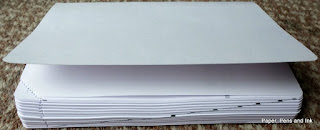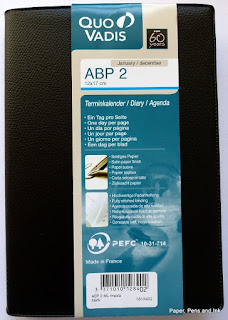 |
| Stamford Notebook Company Traveller's Journal |
Okay, so I bit the bullet (see
this post) and moved into my
Stamford Notebook Company Traveller's Journal. How have I set it up and how is it working out?
1. How have I set it up?
The SNC Traveller's Journal came with the booklets held in with leather cord and a leather cord to wrap around a button on the front to close it (see photo above). I've changed both of those. My inserts are held in with elastic cord. I've got 4 cords in total, threaded through the two holes (so yes, they are in the same place inside, but it's working without any problem - the inserts just move to the side). I found the leather cord too thick around the inserts so writing on the page was affected. It looked nice (and different to other Traveller's Notebooks/Journals) but it wasn't all that practical.
I've also swapped the leather cord that acted as a closure for an elastic loop that is secured to the back of the cover with a couple of buttons (to stop it falling off), but I may move back to the leather cord because I quite liked it. It's just that it makes a big lump in the back of the cover where the knot in the cord is and it's hard to write in the notebooks with it in.
Any organiser I use
has to act as wallet, diary, planner and notebook or I'm lost. I've tried having them separate but I invariably leave the house without one and then find I need it. Hence the set-up I have.
First up are two Midori inserts -
the zipped pocket and the credit-card holder. I have these around the first two elastics, with the zipped pocket first then the credit-card holder.
Coins go in the zipped pocket. I can't cope with not being able to see my coins now, having used a clear pocket for several years. I like to know when I go to pay for something whether I have enough change or whether I need to split a note. The zipped pocket insert is pretty sturdy and holds the coins well. I sometimes have my Zebra diary pen/pencil in here too as I haven't put any kind of pen loop in there yet.
 |
| Coins in the zipped pocket at the front |
The other half of the zipped pocket insert has two slip
pockets. I have paper money in one side and I put receipts and vouchers
in the other side. For some reason, I thought I was short of card slots
and so I put a stick-on one on the back of the slip-pocket. I could
unstick it but I'm happy to leave it there!
 |
| Slip pockets. The paper behind them is to hide my cards |
Next up are cards. I don't really want to show you them. I'm sure you all have enough imagination to be able to picture bank and credit and store cards in a plastic card holder. It holds three per side and 12 in total. I use one for stamps. The slots are quite loose and so some cards are doubled up.
Then comes the home-made week + notes diary in the (horrible) Moleskine cahier. The washi tape and sellotape holding it together are because I was slicing out some pages I had been experimenting on and sliced a bit too close to the spine! The stamps and washi are me just playing about. To be honest, I rarely even see the cover!
 |
| Paper is hiding my cards. The notebook on the right is my week + notes diary |
 |
| The week + notes layout |
I've deliberately photographed an empty week! But it hopefully gives you a bit of an idea about the layout. On the left are the days and a box for tracking things; on the right, the page is divided into eight - six life-areas (currently unlabelled), 'other' and 'next week'. Tasks and to-do items are assigned to one of the boxes and the next week box is so that I know what's coming up as I am pathologically incapable of turning the page and looking.
The day stamps on the diary side come from a set I bought from eBay. The Things to Do stamp came from Hema. I use the Things to Do stamp to write down my most important tasks for the day. The rest of my day planning is still being done in a reporter's notebook that stays on my desk. I use that to block off time for tasks and as a general scribble pad and then throw it away when it's finished. Despite having written the date range of the diary on the front cover, I'm likely to throw that away when it's finished too. Don't all gasp in horror. I keep a separate diary in which I jot important things about the day that I will want to remember in the future, and knowing that I needed to arrange a chimney sweep in such and such week is
never going to be important to me and so stays in planners that I throw away when they're done. It's a planner. I plan in it. Once the plan is finished, why would I want to keep it?
[Sorry - I've never understood why people do, unless they are planning and journalling in the same thing, which is also a concept that defeats me - why would you want to muddle all that up?]
Anyway, moving on...
After the diary is another (hateful) Moleskine cahier that I am just using up to use up. I will never buy them again. I learned my lesson. I'm using it as a scribble pad. In it are going order numbers (crossed out when the item arrives), books to look out for, things to remember to do (noted down while I'm out and about; things that occur to me at home tend to go on the reporter's notebook page) etc.
 |
| Back of the week + notes diary (l); notes cahier (r) |
Okay, that's the set-up...
2. How is it working out?
It's been working out really well so far. The footprint of the Traveller's Journal is bigger than a personal Filofax but the layout is working much better for me and the overall weight is about the same as a personal Filofax (though more than a slimline, naturally). The larger footprint is no problem as it's not really much heavier/larger than the Filofax and to be honest, the better layout of the planning bit more than makes up for it. Being able to see my weekly tasks, set out in the different life areas makes me see where I end up doing too much and what I still have to do in the week. Using time-boxing in the daily plan in the reporter's notebook stops me from overloading a day (and procrastinating!). It's all working pretty well at the moment.























